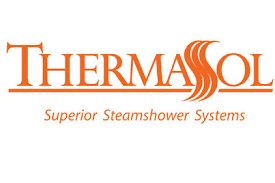Avoiding Condensate
Condensate is what makes steam wet and muggy. It is heavy and either falls to floor fast or rises if too hot and sticks to the ceiling and walls. Condensate in steam holds a lot of heat and heats up the walls and is what causes steam traps at the top of the ceiling, especially with ceilings 8 foot and higher. Wet steam will make the steam room feel more like a sauna. Dry steam is the steam that stays in the air. Dry steam has less condensate and is comfortable to steam bathe in.
Some steam generators have a much lower psi than 20 psi and have smaller piping (less than 3/4 inch). Single tank steam generators produce the most condensate. They are a fast burn type that put out lots of hot steam and then there is a duty cycle where you have to wait till the next steam session kicks on. Single tank models are most known for steam traps at the ceiling due to high condensate. The steam generators that give off the least condensate have very low sensible heat in the steam. If using pressurized steam, the best steam works at 20psi and uses 3/4 to 1 inch piping. The larger the killowatt size, the more you will need a 1 inch pipe.
The reason single tank steam generators produce so much condensate that creates a steam trap at the top of the ceiling is because water holds the latent heat. If too much steam is dumped out at once (faster than it falls to the floor) it will rise (Brownian motion is the reason). When the ceiling gets too hot it creates a steam trap and the heat and steam has a hard time falling to the floor unless the ceiling cools down. This is why keeping a bucket of cold water and if you have a steam generator that makes a very wet steam, I splash all the upper walls and ceiling with the cold water and the room is now cloudy and steamy again. All steam rooms are steamy when they first get started. The first 1/3 of the session is nice but the last 2 thirds are drippy and muggy.
Note: dry steam does not mean less steam. It means there is less condensate in the steam. There is less unevaporated water. Many people call me up saying they want their steam wet. They want the steam so thick that they can't even see someone a few foot away from them. These people are so ignorant. A room where you can't see someone due to heavy steam is a factor of the room (the temperature of the walls, the height of the ceiling, and how porous the material is. Next time you go to a spa, if you splash cold water on the upper walls and ceiling you will have a steam room where you can't see a person on the other side of the room. But, if the steam starting out has a high dryness fraction and has low water hammer from the start, that will keep it has steamy as possible without the wall stick and steam trap.
Heat Types:
Each steam generator brand can have a different heat type than you might expect if comparing to the one you have been using in the gym or spa. Most people have only experienced commercial steam rooms and when they but a residential one the steam is nothing like those other ones. Depending on the dryness or wetness of the steam generator, the room will be heated up differently. The steam generators that put out more steam at the same temperature will have a wetter steam and wont transfer the heat to the room like the high fluence lower output models.
Note: when the steam droplets from on the walls and ceiling, its is just heating up the walls and the heat is drawn out of the steam room. My goal is to lower the latent heat index and raise the heat coefficient.
Higher wattage and higher output steamers might put out more steam but if the vapor size is too big it will effect how hot the steam rooms gets. The dryer the heat for some can feel more like a sauna. Many people like to breath in steam to help with colds while other people want to sweat out toxins or burn calories.
If trying to detox, the longer I am in the steam room getting a slower sweat where I am not just sweating like a pig and getting my heartbeat up. This depends if trying to burn calories or sweating toxins from the oil glands. (Sebaceous sweat). Remember, fat soluble toxins are not the same as water soluble toxins that many people think they are sweating out when in the steam room (or a sauna).
Heater types
High vs Low Density Heaters - separates the cheap from the good
This is another thing that companies don’t take the time to explain to people buying a steam generator. High density heaters are the heaters everyone wants to avoid in their generator.
High-density and low-density heaters refers to the amount of wattage the heater uses compared to the total surface area of the element. The really cheap generators with high density use a super high temperature to operate.
Some steam generators have 11 foot heaters while the standard is 2.5 feet. The more surface area the less limestone buildup on the heating elements. Also, bigger heaters will last longer. The larger heaters don’t heat the water faster but touch more water at the same time as with nearly 3 times the surface area touching the water makes for a dryer steam. I only recommend the 11 foot heaters for those that are not using a water softener who have hard water.
Note: If getting a steam generator with 11 foot surgical steel heaters, the only way to damage them is if it wasn’t installed correctly and the water pressure reducer was not there.
When to get better heating elements
For those that have hard water or not using a water filter I urge people to only use 304 grade surgical steel heating elements. I get so many pictures of heating elements that are ruined from limescale. Surgical steel heaters are the mostv resistant to limescale. I have never heard of a surgical steel heating element break from limescale. The really cheap heating elements usually found on on the budget steam generators can use cast aluminum heating elements or standard metal (standard stove element). The middle quality brands usually use stainless steel elements. For that never want to worry about replacing their heating elements in their steam generator should make sure the generator has 304 grade surgical steel heating elements. 304 grade is the hardest steel and least prone to limescale corrosion. Having a high corrosion resistant 304 surgical steel heating element as well as a 304 surgical steel boiling tank is the best for maintenance free use.
Mild vs intense
Steam under pressure heats up way faster but people sacrifice poorer quality steam for this impatience, mainly the low psi models with 1/2 inch pipes. The steam generators using high pressure produce very fast steam and it gets very intense but also has the shortest duty cycles where most of the time the steam is off. Some people like these bursts of intense steam followed by no steam and a longer delayed wait time. Others like a more constant milder steam that typically the non-pressurized tanks give. The open tank steam generators still get very hot but only have a few degrees of temperature change until the steam kicks on again so there is always a dense cloud of steam.
Note: if the steam is too hot, the water droplets in the steam that never turned into vapor will still appear like steam since they are small enough not to fall yet since the vapor keeps it in lifted up in motion. There is more heat in the room from the wetter steam but not as much steam vapor.
Those that have been in the steam rooms at the gym who feel the need to pour water on the sensors will probably like a more continuous steam. Many people upsize their kilowatt size one size up if a more intense steam is preferred. I would not upsize a pressure cooker type but only an open tank so the steam stays drier.
Some people will want steam heated up in a pressure cooker type steam generator beyond the boiling point. I do not recommend this. The goal is to get as much steam vapor and less humidity and moisture in the water. When the steam being condensed in the room and the steam being made by the generator are in equilibrium, this is when the steam quality is at its highest dryness. This will give the best steam experience for those building their own steam room. If the room is not in equilibrium and the steam doesn’t have enough time to condense before it comes on again, this can cause even the driest steam to become wet.
Steam Quality - sizing charts give zero help with this -
We measure each steam generator we review from 0 to 100 based on the type of steam it gives out. A generator that gives out steam with 100% vapor would get a 100% rating. If it has a 15% condensate (non vaporized water), then we would rate it at 85%. I do not like going in a steam room where it has a high moisture in the steam. High pressure cooker steam generators have less duty cycles as they shoot out steam quicker but high pressure steam is a much wetter steam unlike the open tank steam generators that have the highest dryness fraction.
Know before buying a steam generator
Know before buying a steam generator
Know before buying a steam generator
DiscountSteamGenerators.com
We're open now
1-800-336-9285
Ask for Sharon
We're open now
1-800-336-9285
Ask for Alex
DiscountSteamGenerators.com
We're open now
1-800-336-9285
Ask for Sharon
We're open now
1-800-336-9285
Ask for Alex
Notice: it is hard for most people to stay in the steam room for a long session when there is high condensate. If more steam is generated after the room is already at 100% humidity, it makes it hard to breath and most people start coughing. If the steam generator is still making steam when your hygrometer says you are in the 110 114 degree range and its at 100% humidity, it makes it easy to tell if your steam is too wet and has too much condensate. Some generators put out way too many grams of steam per minute, faster than it can fall to the floor and this creates the uncomfortable mugginess that I never want to experience.
Oversizing a generator and getting a generator with a low dryness fraction can be the biggest mistake in choosing the right steam generator. Take my steam room quiz. It helps!









